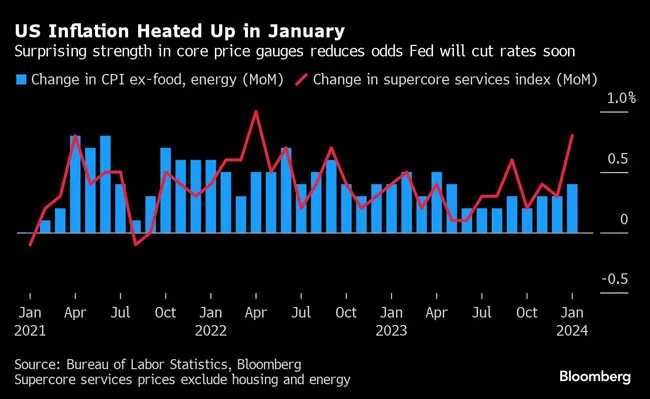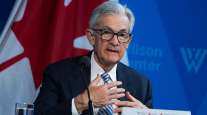Bloomberg News
Inflation Tops Forecasts in Blow to Fed Rate-Cut Hopes

[Stay on top of transportation news: Get TTNews in your inbox.]
U.S. consumer prices jumped at the start of the year, stalling recent disinflation progress and likely delaying any Federal Reserve interest-rate cuts.
The consumer price index rose by more than forecast across the board in January — on a monthly and annual basis — as did the core measures, which strip out food and energy costs. A key subset of services prices advanced by the most in nearly two years, and shelter costs heated up, government data showed Feb. 13.
The figures further reduced already-slim chances that Fed officials will start lowering interest rates soon, and any additional reacceleration risks reigniting talks that they will resume hikes. Some policymakers have said they want to see a broader easing of price pressures before cutting rates.
The S&P 500 opened lower, and Treasury yields jumped after the release from the Bureau of Labor Statistics. Traders pushed out bets of when the Fed will start cutting rates and marked down March odds to almost zero.

Economists have long contended that the path to 2% inflation — which the Fed targets, based on a separate index — would be arduous, and the CPI release suggests it may be longer and bumpier.
Many forecasters still maintain that inflation is broadly on a downward trend, and that the January inflation surprise likely won’t translate to the Fed’s preferred measure, known as the personal consumption expenditures price index.
“The Fed will view this as another reason to wait until May or June, but the direction of trend is still lower,” said Kathy Jones, Charles Schwab’s chief fixed-income strategist. “With much of the increase due to housing, it’s a waiting game to see when those costs will come down.”
The figures reflected increases in the price of food, car insurance and medical care, while shelter costs contributed to more than two-thirds of the overall increase. Outpatient hospital services and pet services both posted record monthly advances.

Via Bloomberg News
There was, however, some favorable news for American consumers. Prices of used cars dropped on a monthly basis by the most since 1969 after the methodology was updated. Broader goods prices and energy also continued to fall, underscoring policymakers’ concerns that the recent disinflation has been concentrated in a few categories.
Last week, the BLS’s annual revisions confirmed inflation receded as fast as initially reported at the end of 2023. But new weightings — which are effective as of the latest figures — will place a greater emphasis on services and less on goods, which economists say will slightly boost the outlook for the CPI this year.
Shelter prices, which is the largest category within services, advanced 0.6%, matching the steepest gain since early 2023. Economists see a sustained moderation in this area as key to bringing core inflation down to the Fed’s target.
“The January CPI report shows it won’t be a smooth road to get inflation back to 2%. ... Our base case is for the Fed to begin cutting rates in May — though if the troubling signs in this report persist, the risk of a later cut rises,” Bloomberg economists Anna Wong and Stuart Paul said.
Excluding housing and energy, services prices climbed 0.8% from December, the most since April 2022, according to Bloomberg calculations of the measure known as supercore. While policymakers have stressed the importance of looking at such a metric when assessing the nation’s inflation trajectory, they compute it based on the PCE index.
Want more news? Listen to today's daily briefing above or go here for more info
The PCE doesn’t put as much weight on shelter as the CPI does. That’s one reason why it’s trending much closer to the Fed’s 2% target.
The Feb. 16 release of the producer price index will provide more clues, as several categories within that report feed directly into the PCE price calculation. The PCE figures will be released later this month.
Unlike services, a sustained decline in the price of goods over most of the past year has been providing some relief to consumers. So-called core goods prices, which exclude food and energy commodities, fell by the most since July.
Fed officials will have access to multiple inflation reports — including one more CPI print — before their next policy meeting on March 19-20. Though Wall Street has been pushing for the central bank to start easing rates, policymakers have indicated they’re likely to stay on hold for a fifth straight meeting.
That’s in part due to the strength of the jobs market. A separate report Feb. 13 showed real earnings advanced by the most since July on an annual basis, extending a monthslong streak in which wage growth has modestly outpaced inflation.




